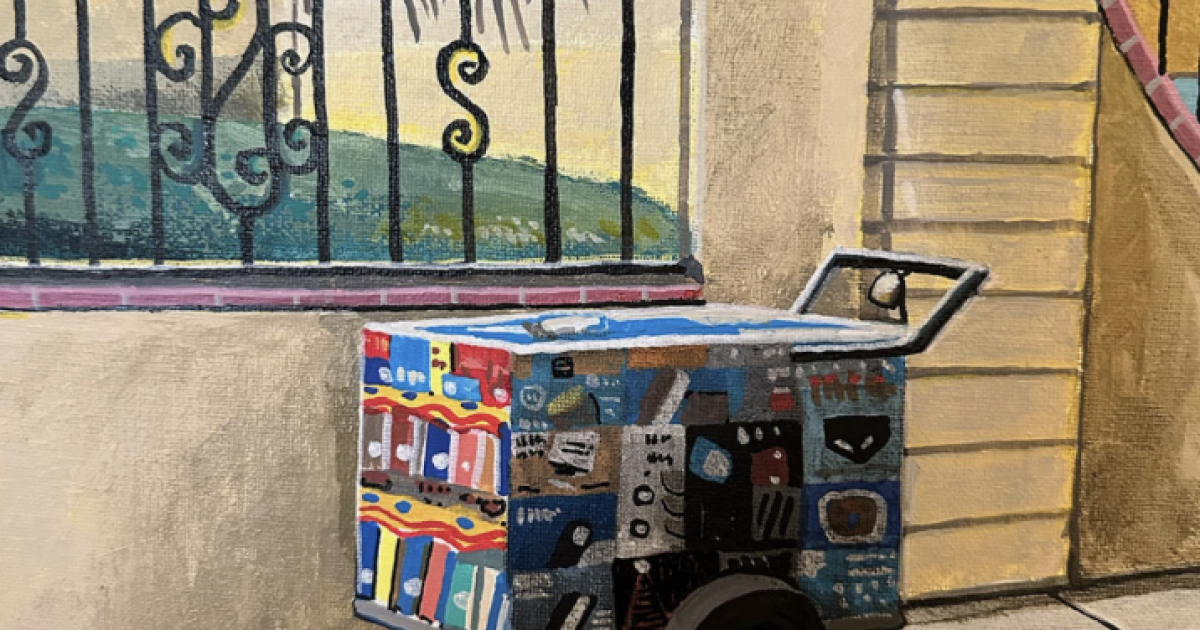For decades, L.A.-based cartoonist Lalo Alcaraz has been creating one-panel editorial cartoons that condense complicated political issues into straightforward images.
That’s what he did with a recent cartoon for Caló News that depicted a federal immigration agent with a block of ice for a head, on the run from a group of people screaming and protesting, and the words “ICE OUT OF LA!” superimposed.

Cartoon by Lalo Alcaraz for Caló News in response to ICE raids.
“I think people want to feel solidarity, and I am happy to try to provide any kind of bridge, an image that brings us all together in anger… and feel like we’re not alone,” he said.
ICE raids have not only inspired activism — but art
This week he finished an acrylic on canvas painting of a photo that went viral. The photo depicts a paleta (popsicle) cart on the sidewalk in a residential neighborhood. Missing: the vendor.
The paletero was detained by agents in Culver City. Alcaraz is selling prints of his painting to help the man’s family.
Alcaraz is one of dozens of trained and experienced visual artists who are lending their skills to create images for the recent movement against the immigration raids in Southern California.
It taps into a long history of art as social protest, such as posters for the Black Civil Rights Movement, Keith Haring’s paintings for AIDS awareness in the 1980s, and Yolanda Lopez’s “Who’s the Illegal Alien, Pilgrim?” used in 1990s Chicano Movement protests.
Strong visual images give people a way to express their feelings
In recent Southern California protests some participants held up a small poster-sized image showing a large hand coming out of a school building. Above it are the words ¡NO PASARÁN! (they will not enter) .
— Lalo Alcaraz, artist, cartoonist
Some two thousand of these prints were created in the last few months in Los Angeles.

Linocut created by John Fleissner for people protesting ICE raids in Southern California.
“¡NO PASARÁN! is a slogan that originated in the Spanish Civil War, when the democratically elected government had to fight off the fascist insurrection,” said John Fleissner, the creator of the image.
He’s a Milwaukee high school art teacher who was brought to L.A. by a labor union to organize a screen printing event at “Summer of Resistance” — a month-long event at Olvera Street in downtown L.A. where the silkscreen prints were made.
— John Fleissner, printmaker
He’s inspired by artists like Jose Guadalupe Posada, who created graphic art during the dictatorship of Mexico’s Porfirio Diaz at the end of the 19th century.
“A poster, an image, a striking image, really hits you in the face and gets you to understand and elicits that emotional response in a split second,” Fleissner said.
Venting anger through profanity
Two of the most common phrases you can find on handmade signs and banners are: “F*** ICE” and “Ch**** la migra”. Both essentially mean the same thing.

The artist Dewey Tafoya used an image of the late writer Octavia Butler, who wrote about a future in which authoritarian governments limit people’s rights.
“That is like our … slogan and war cry for these protests,” said Savannah Rosas, a student at Otis College of Art and Design. “That simple phrase, I feel like, has brought so many people together to really speak out and to help our immigrant community and just bring our voice back.”
Before the immigration raids, Rosas said she created work that evoked childhood and hyper-femininity. She grew up in Bakersfield in a working-class family. Seeing people detained who looked like her parents and grandparents shook her to the core.
She created a digital print that depicts a bag of ice with those phrases on the bag.
“Us being depicted by the government as these villains was just so enraging,” she said.
Using Labubu, Snoopy and other characters to protest ICE

The artist Dylan Jagielski says he’s influenced by underground artists like Sand One and OGBillyTheKid.
Courtesy Dylan Jagielski
)
Artists are also using well known pop culture characters, such as Snoopy and Labubu to send a message opposing ICE actions in L.A.
The artist Erica Friend used the Labubu character to communicate a message protesting ICE raids.
@insomniart
/
Courtesy Erica Friend
)
Some Latino artists have used the chancla (a slipper, flip flop) to communicate anger.
“The chancla represents that brown matriarchal power,” said Gilda Posada, a printmaker based in Lynwood. “It’s a symbol usually of moms or brown aunties being frustrated and throwing their shoe at you.”
Posada printed 200 copies of an image she created showing a hand holding a chancla and pointing it at a law enforcement officer.
According to reports of detentions, people who appear to be of Latin American descent have been the principal targets for federal agents, but Asian Americans are also concerned.
Asian American cartoonist Sam Nakahira created two “ICE OUT OF LA” pieces.
Art as spiritual work

Artist Joel Garcia used a mountain lion image, similar to L.A.’s late P-22, to communicate a connection to the indigenous origins of the L.A. area.
Some visual artists are using the moment to remind people that the anxiety, disruption, and family separations resulting from detentions are happening on indigenous lands.
In one work, a mountain lion resembling L.A.’s famous P-22 looks straight at the viewer under the words, “I.C.E. FUERA DE TOVANGAAR – LOS ANGELES” (I.C.E out of Tovangaar, the indigenous name of the L.A. area).
“The [mountain lion is] walking down from the heavens… like where our ancestors are and it’s coming down as a protector,” said Joel Garcia, who created the image.
— Joel Garcia, artist
He wanted to create work that didn’t use hyper-masculine imagery, like a raised fist or muscular male figures.
“Artists, they do spiritual triage,” Garcia said. “They assess where the work is needed, where creativity can help support the spiritual, mental, emotional wellbeing of people.”

